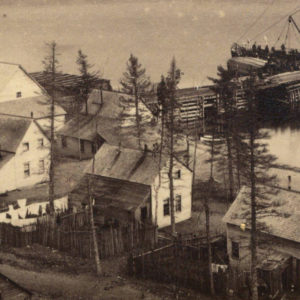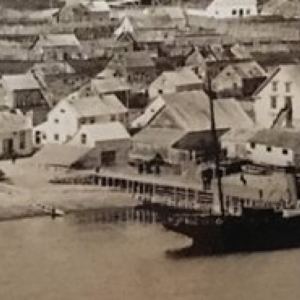 The Mining Company owned and operated stores in Little Bay. The stores were present immediately in 1878. There were two Company store locations. One at each of the main districts, namely the Bight and Loading Wharf. Miners were paid in a Company script which could be used to purchase provisions from the stores.
The Mining Company owned and operated stores in Little Bay. The stores were present immediately in 1878. There were two Company store locations. One at each of the main districts, namely the Bight and Loading Wharf. Miners were paid in a Company script which could be used to purchase provisions from the stores.
I believe I’ve flushed out how the Company stores operated with references to the employees and their job titles for the mid to late 1880s. George Quimby held the position of Head Shopman. He was the manager of the stores and likely oversaw both locations. Each location was in turn operated by a Paymaster or Cashkeeper along with a Shopman.
 The Shopman oversaw the operation of clerk services while the Paymaster handled the books. Paymaster was the higher rank. In Paymaster Lind’s journal his job appears to be entirely focused on money and accounts. His references to work involve bookkeeping, placing and paying orders, paying the miners, and managing shopping debts and advances.
The Shopman oversaw the operation of clerk services while the Paymaster handled the books. Paymaster was the higher rank. In Paymaster Lind’s journal his job appears to be entirely focused on money and accounts. His references to work involve bookkeeping, placing and paying orders, paying the miners, and managing shopping debts and advances.
The Company store in the Bight had Henry Lind as its Paymaster with Ernest Berteau employed as a clerk. Henry’s son Willy also worked there. The wharf prominent in 19th century pictures of the Bight was part of that store. If you follow the wharf back to the shore on the photos included here you’ll see the building. I’ve yet to find a picture of the Loading Wharf location which had Giles Foote for the position of Cashkeeper and George Thompson for Shopman.
 A job at a Company store was a coveted position. It provided status and offered opportunities for career advancement within mine management. Further, stores were closed for public holidays such as on the following dates in 1888: January 2nd for New Year’s Day, March 17th, March 30th, April 19th, May 24th for the Queen’s birthday, August 6th, December 25th and 26th for Christmas.
A job at a Company store was a coveted position. It provided status and offered opportunities for career advancement within mine management. Further, stores were closed for public holidays such as on the following dates in 1888: January 2nd for New Year’s Day, March 17th, March 30th, April 19th, May 24th for the Queen’s birthday, August 6th, December 25th and 26th for Christmas.
A shop gig came with perks but landing one required connection. Early positions were likely appointed by the Baron directly but later, under the English company, nepotism became an even bigger factor and ethical standards dropped. Underhanded deals were made between the company managers and shop employees which took further money off the miners. Ernest Berteau was accused by one newspaper of pocketing money through a middleman import scam. The miners had no way to refuse. They were forced to buy from the Company. It should be noted that the privately owned establishment called Lamb’s Corner had a working relationship with the Company shop and would order items on behalf of others and sometimes even take over indebted accounts.
The store placed the town’s shipping orders and held the provisions provided over the year. Orders were sent overseas with many of Little Bay’s supplies sent from Swansea in Wales. What was ordered could take all summer to arrive and there was no ocean shipping at all once the water froze for the winter. The Company shop provided the necessities of life and more including; groceries, clothing, furniture, appliances, industrial supplies, educational materials, decorations, and even novelties like sky rockets for public celebration.
I’ll end this article with a list of things that be could purchased at a Mining Company store as recorded by their shipping orders and debts. It’s not a complete list but it will demonstrate the sheer variety of shopping options available in the 1880s. Let me know if you see anything you want!
Shop items:
- Cigarettes
- Tobacco
- Sole leather
- Rubber shoes
- Child’s lace boots
- Homespun
- Turkish dyes
- Clocks
- Rings
- Bull’s eye lantern
- Spring bottom glass globe
- Hanging lamps
- Candles
- Paraffin oil
- Kero oil
- Soap
- Razors
- Sky rockets
- Canadian flag
- American axes
- Cartridge shells
- Pork
- Beef
- Flour
- Bread
- Soundries
- Beer
- Sweets
- Sardines
- Oysters
- Dried currants
- Cut leaf sugar
- British refined sugar
- Sauce cocoa
- Baking soda
- Anglo Swiss milk
- Loose raisins
- Mix pickles
- Corned beef
- Salted crackers
- Potatoes
- Envelopes
- Printed books
- School books
- Black lead pencils
- Bottled ink
- Writing paper
- Mathematical instruments
- Pig iron
- Portland cement
- Manila rope
- Marline twine
- Fire clay bricks
- Earthenware
- Steel wire rope
References:
- 1878 – Rev. Harvey noted the stores present during his visit (Harvey)
- 1879 – A well built store with a fine wharf (Journal of the house of assembly)
- 1880 – I suspect A.S. Kidston may have been running the Company store (Lind)
- 1881 – “Stores for grain, hay, provisions and necessary mining stock have been erected (HGS, July 2)
- 1881 – The store was attached to the establishment (Kennedy)
- 1881 – There are Company stores (ET, June 21)
- 1882 – Company store in Little Bay (ET, Dec 2)
- 1883 – Police walked to the Company’s shop (Wells)
- 1885 – In December there was a break-in at the Mining Company shop and store located at Loading Wharf. The shopman Mr. Thompson and the cashkeeper Mr. Foote worked at the Mining Company shop located at the Bight. There were groceries held at both locations (Wells)
- 1885 – Henry Lind “obtained a position as the Company Storekeeper (Taylor). The work is recorded in his journal and consisted mainly of paying the workers (Lind)
- 1886 – Willy Lind worked in the Company store with his father (Taylor)
- 1886 – The Mining Company Store is described as one of the striking features to see while arriving in the harbour along with the churches (DC, Sept 7)
- 1886 – E. Berteau is clerk for Paymaster Lind. Berteau is said to give ten percent of recites for the use of the wharf and stores to the company instead of rent as part of a scam with T. Walsh “time keeper on the works” (DC, Sept 7)
- 1886 – Mr. Foote was cash-keeper for the Mining Company shop in the Bight (Wells)
- 1886 – George Quimby was Head Shopman (Wells)
- 1887 – Mr. Quenby was manager of the stores (TS, Jan 1)
- 1887 – Rum left in the Company store at the wharf (TS, Feb 19)
- 1888 – The stores were closed on January 2nd for New Year’s Day, March 17th, March 30th, April 19th, May 24th for the Queen’s birthday, August 6th, December 25th, and December 26th (Lind)
- 1888 – Billow Crest left Swansea in June and is noted at St. John’s in September. I should be able to pinpoint it in the Lind journals and give a sense of travel time for shipping. If I can find the day I could check it against Wells entry
- 1890 – Seed potatoes sold at the Company Store (TS, June 7)
- 1892 – Henry Lind stopped working at the Mining Company store (Taylor)
- 1895 – Detailed lists of who owes John Lamb for which product are recorded. This is one of the sources that may provide a window into items sold at the shop but it questions the relationship between the company owned shop and Lamb’s private business. It appears that Lamb would order and pay for items for others with their names recorded under his account. He would also take over other people’s balances. My best guess is that people owed both Lamb and the company shop money and a system was worked out between them (Ledger)
